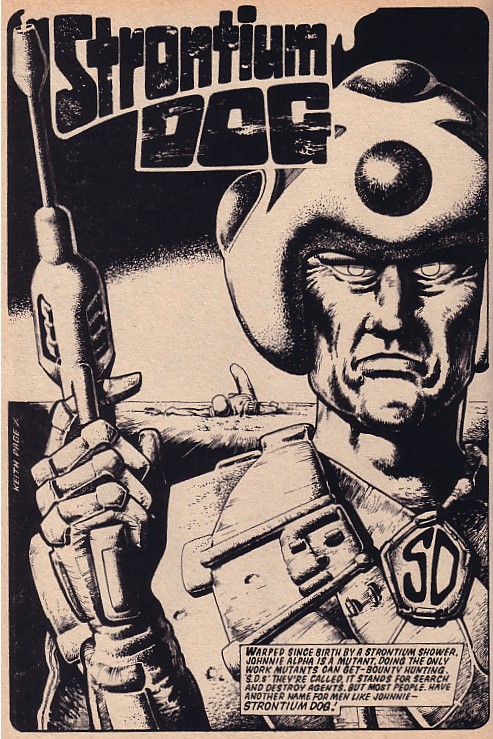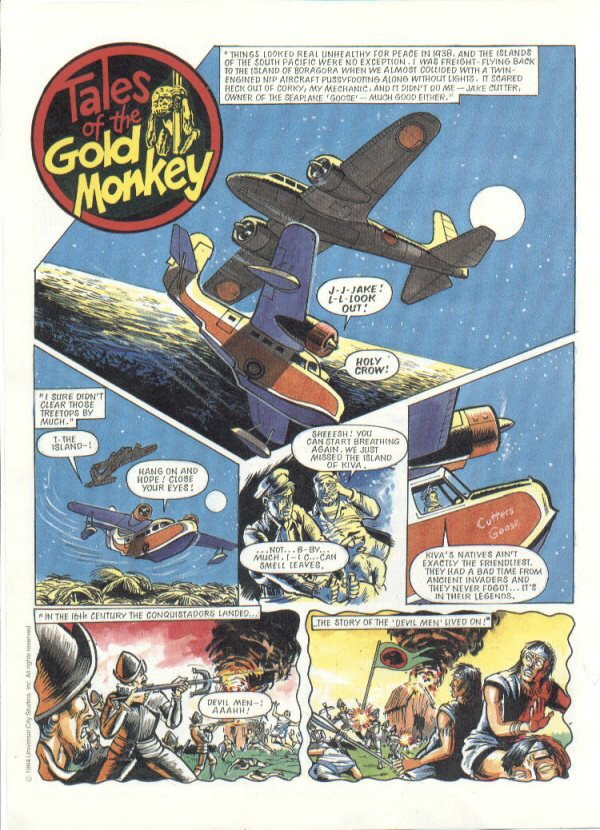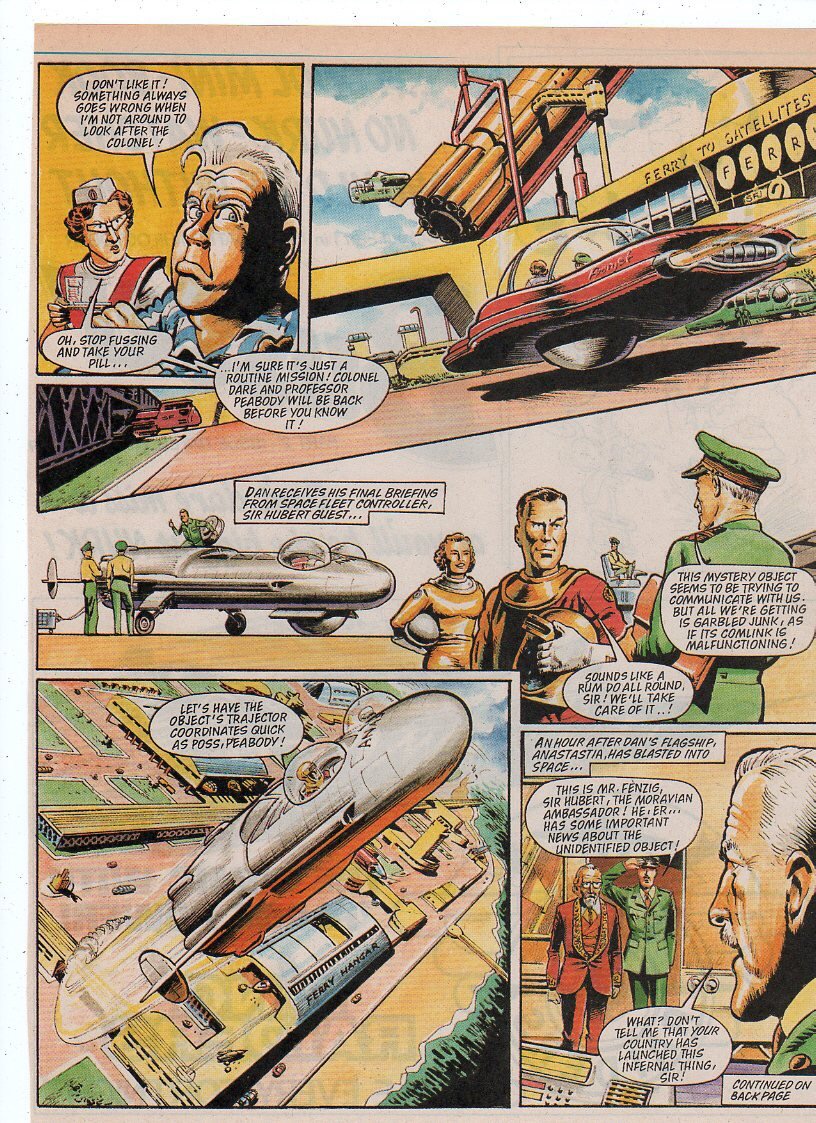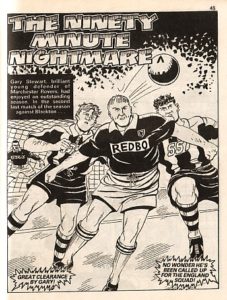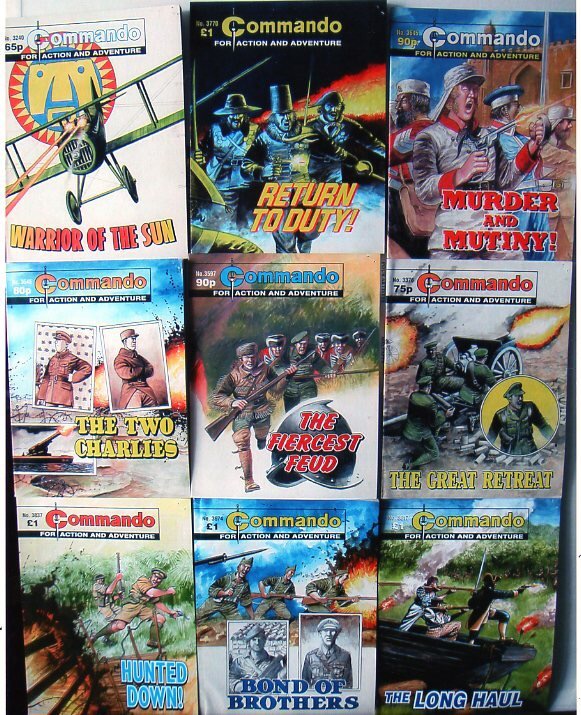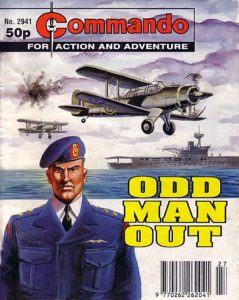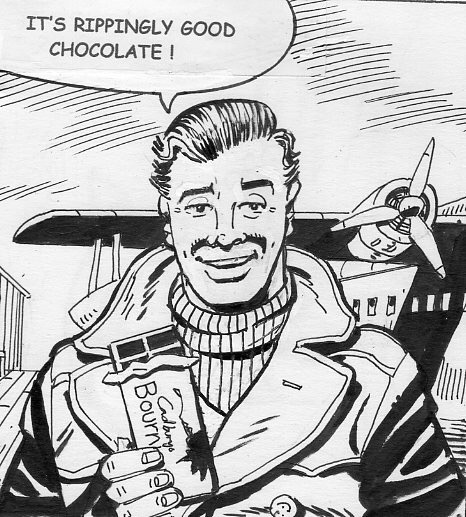First published: 14th April 2009
Keith Page is one of the regular interior and cover artists on DC Thomson’s Commando as well as writing and illustrating the Dan Dare prequel “Rocket Pilot” in Spaceship Away.
As a part-time artist he worked on 2000AD, “Dan Dare” (for New Eagle) and TV Comic annuals before going full time illustrating Thunderbirds and Stingray in The Sunday Times.
downthetubes: Where are you from and what comics did you read as a child?
Keith Page: I’m from what is known today as Village London. I’m old enough to remember the first Doctor Who series and used to read the later Eagle and TV Century 21. I got hold of a complete run of Eagle 1950-60 and was fascinated by the work of Frank Hampson – Frank Bellamy to a lesser extent.
downthetubes: Are you a trained artist?
Keith: I had no art training beyond school A-level. My first job was selling houses and then I became involved in building surveying for a couple of years. I drew comics part-time until about 16 years ago.
downthetubes: Where was your work first professionally published?
Keith: My first work was published in Denis Gifford’s Ally Sloper magazine in, I think, 1976.
downthetubes: The “Hunter” strip in Ally Sloper was very influenced by Dan Dare. Did you get to meet any of the original Eagle artists?
Keith: I met Frank Hampson a few times and he encouraged me in my work. Years later I met Keith Watson and Don Harley. I’ve never really what you might call a comics fan as such, though.
downthetubes: As you were then a part time artist, how did you get involved with the Temple Art Agency?
Keith: I used to take my portfolio along to the old Fleetway offices in Farringdon Road and saw the editor of Lion a couple of times. I also visited various newspapers and met the cartoon edition of the Daily Express one day. He suggested I try the Temple Art Agency, rang Pat Kelleher up and I went along to see them the same day.
At that time the Temple Art Agency was run by Pat and his father from an office in Chancery Lane. They represented people like Ron Embleton, Don Lawrence and Ron Smith, also Mike McMahon a little later.
downthetubes: At that time you did strips for the 2000AD family of annuals including “Judge Dredd” and “Strontium Dog” stories. How did you get involved with the title?
Keith: I met Pat Mills in King’s Reach Tower just before 2000AD was launched. He gave me a sample Judge Dredd script to try, but I did not do a very good job. Similarly I did a couple of Starblazer samples for DC Thomson but I had not enough drawing experience to do them properly.
All work from DC Thomson came via Temple, as indeed did the work for TV Comic.
downthetubes: Your TV Comic strip was “Tales of the Gold Monkey” (an adventure series starring Stephen Collins, Jeff MacKay, Caitlin O’Heaney and Roddy McDowall). As this was based on the US television series, you had to draw likeness’ of the main cast and as well as the aircraft used in the series. What sort of reference material were you provided with?
Keith: The only reference material I had for “Tales of the Gold Monkey” was a single poster magazine. I never saw the TV series at all, I coloured the work myself.
downthetubes: You also illustrated “Tales of the Gold Monkey” in the 1984 TV Comic Holiday Special and the 1985 Annual. Were the writer and editor the same and did you get a longer deadline for them?
Keith: I do not know much about the script writers for the Annual stories but there was always a generous deadline.
downthetubes: One of the more unusual annuals you worked on during this time was the 1986 Supergran annual published by Grandreams, again based on the ITV series. Grandreams, and Brown Watson before them, seem to have something of a tradition of using up and coming artists such as John Bolton, David Lloyd and John Higgins as well as established artists like John Cooper. How did you get involved with the company?
Keith: The work for Grandreams came via Temple again. I was given a video tape and some stills, I think, to work from.
I enjoyed working on a comedy theme. A lot of the current Commando stories are humorous and I think the art is fairly subtle, nothing too slapstick. I like to visualise how a good actor would portray the character.
downthetubes: The weekly adventure comics were a dying breed during the late 1980s and you worked on a variety of short run titles such as IPC’s Revolver, Ring Raiders, MASK, Wildcat and Supernaturals. Did you have a particular favourite amongst these titles?
Keith: My favourite in the 1980’s was the one-off story I wrote and drew for Revolver – “Martello 112“).
There was to be a follow up about William Shakespeare, but the magazine was suddenly cancelled before it could appear, which was annoying.
(Later, I did a full-painted story, “Sparkster the Rocket Knight“, for Sonic The Comic, which was never published because IPC found at the last moment that they had only rights for one story. Fortunately they had to pay me, though! I still have the art work and I was quite pleased with it).
MASK and Supernaturals were really about selling toys. Good practice at drawing for me, but little content to get interested in.
downthetubes: You then drew “Dan Dare” for the modern version of Eagle. The character of the time was the revitalised version following on from Keith Watson’s revamp of the strip.
Were you pleased to be working on that version which was much more in the original Frank Hampson style than the previous Marshal Dan Dare incarnation that the comic had?
Keith: I was pleased to be involved in the revival of the original Dan Dare. Although I had drawn some annual stories for the earlier updated versions, I was never happy with them. Keith Watson did an excellent work on the first story. He did however tell me that he had to rewrite parts of the script because the scriptwriter was somewhat lacking in his knowledge of the original character.
As far as I was concerned, there were two problems. Firstly, I was working as a part -timer and had very tight deadlines, too tight for the high quality of work required.
Secondly, there was a continual push to “update” the look of the artwork, which I believe was to do with a proposed TV series. And there was a curious editorial fascination with airbrushing everything, which was largely unnecessary and did not help the finish result at all as far as I was concerned.
Another difficulty was that there was some sort of editorial feud prompted by the Revolver version of Dan Dare [written by Grant Morrison and drawn by Rian Hughes]. That is why I was told to draw a Judge Dredd type figure in the last story I drew. After that the whole thing deteriorated into a shambles.
One thing I would say is that if Dan Dare had been a DC Thomson character they would have done a far better job.
downthetubes: In 1992 Alan Fennell, who had edited TV Century 21 comic in the 1960s and Look-In in the 1970s, set up Thunderbirds The Comic to tie-in with the immense popularity of the BBC2 repeats of Gerry Anderson’s series Thunderbirds. How did you get involved with Alan in the first place?
Keith: Pat Kelleher had known Alan Fennell for years and got me the job on Thunderbirds. I became a full time comics artist when Alan asked me to work on both the Thunderbirds comic and the long-running Sunday Times “Thunderbirds” strip feature, which later included “Stingray“. Alan told me what to draw to initially please the copyright people and away I went.
I had enjoyed watching the TV series during its first showing and was pleased to be involved in the re-launch. Alan was a very good editor to work with, very professional. He organised a lot of reference material, including videos as the copyright holders were very particular about getting details right.
downthetubes: You worked on the Thunderbirds full page colour strip in the children’s section of the Sunday Times newspaper, known as The Funday Times, the publication of which preceded the bi-weekly comic. Were there any specific restrictions on you because it was for a Sunday newspaper rather than a bi-weekly comic?
Keith: The Sunday Times was usually an over the weekend rush job as deadlines were tight. Also some of the printing was very bad. You can see the difference in the Annual reprints. I went on to draw Stingray, but Thunderbirds proved more popular and I returned to that with the end of the series.
downthetubes: You also produced painted covers for the Thunderbirds comic as well as its siblings Stingray The Comic and Joe 90. Was this something extra that you specifically pushed for and how much freedom did you have in choosing the cover subjects?
Keith: As far as covers go, I would send Alan a few thumbnail sketches and he would choose some for me to paint. He was very good at keeping me well supplied with work.
downthetubes: Around the same time, unusually, you acted as colourist for John Hicklenton’s artwork for Heavy Metal Dredd in the Judge Dredd Megazine. How did that come about?
Keith: I coloured John Hicklenton‘s Judge Dredd work simply because they were looking for a colourist. I had to colour directly on to photocopies and although John tried some better quality paper, it was never a satisfactory way of going about it. Nowadays of course it would be computer coloured.
downthetubes: You have already mentioned you worked on DC Thomson’s Starblazer, but you have also worked on many others of their titles including digests like Football Picture Story Monthly and Dandy Comic Library Cartoon Books as well as weeklies like Bunty and Beano. With such a diverse range, were there stories that were more interesting than others?
Keith: I have never enjoyed drawing football stories as I have no interest at allin the game. Similarly, the story I did for Bunty. Neither were my sort of thing, I’m afraid. Funnily enough, I still do not like stories with present day settings. To a lesser extent this applies to the Dandy cartoons. “Christmas Carole” in Beano was an experiment at painting a cartoon series. What I would say is that this kind of work is much more demanding than it would appear to be.
downthetubes: Today you have done more than 150 different issues of Commando. Your first issue was Odd Man Out, number 2941 published in April 1996. How did you start on Commando?
Keith: I started with Commando after finishing Thunderbirds because Pat found out that (then Commando editor) George Low was looking for a new regular artist. He gave me the script for “Odd Man Out” and I have been drawing them ever since. George was very good in that he let me use Commando to develop my own style. Initially they were not very good as it was a totally different approach compared to Thunderbirds. It helped that I have always had an interest in things military.
downthetubes: You are in the fortunate position of illustrating most of the covers to your issues and have done since your first issue. Do you enjoy the freedom to produce the entire art for a single issue?
Keith: I like to produce a whole issue myself, and can experiment with different painting techniques for the covers. Of course, some work better than others. [Current Commando editor] Calum Laird and [Chief Sub Editor] Scott Montgomery are very good about this and also usually find stories that they think will interest me. I sometimes suggest story themes that they pass on to the regular writers.
downthetubes: A lot of your Commandos are set during the Great War. Do you prefer the World War One stories or is that just the way they are offered to you? Do you have much say in the stories that you receive?
Keith: I have a particular interest in the Victorian period and World War One. My grandfather was a real-life Charley Bourne (of “Charley’s War” fame), enlisting underage in 1914, awarded the Military Medal at the Battle of the Somme in 1916 and serving in the Home Guard during World War Two.
downthetubes: In addition to the covers and internal story art, you have produced a run of inside cover illustrations on Japanese warriors. Do you have a particular interest in Japanese history and how did this series come about?
Keith: My brother in law lives in Tokyo and sends me some interesting stuff. Apart from the Samurai series, I’ve done a set of British soldiers through the ages and a World War One series that has not been published yet.
downthetubes: You are the regular artist on the “Ramsey’s Raiders” series of stories in Commando written by Ferg Handley. Do you enjoy having regular characters to do and would you like to see Carlton produce a large size reprint book of the Ramsey’s Raiders issues?
Keith: I liked working on the Ramsey’s Raiders series, Ferg did some excellent scripts which have proved to be really popular. We’ll have to see what happens regarding reprints. There is of course a Finnish version of Commando, nicely printed on good quality paper.
downthetubes: You recently produced Commando-style adverts for Cadbury’s Chocolate using a pilot character called Jack Bourneville. How much input did you have to the concept and design of the short strips and where did they appear?
Keith: Jack Bournville was originally intended to be a much more interesting Terry Thomas type character. During the lengthy consultation process between the clients and the ad agency this became much more watered down as things tend to be nowadays. The advertising people were well pleased however and framed the originals for their offices.
downthetubes: Your longest running strip which you write as well as draw and colour is “Rocket Pilot” in the magazine Spaceship Away, which chronicles the early career of Dan Dare’s boss, Sir Hubert Guest. Why chose Sir Hubert as your main character?
 Keith: The problem with Dan Dare is that it is very difficult to update it successfully and still retain the character and charm of the original. I was pleased to rectify this, at least in part with “Rocket Pilot“.
Keith: The problem with Dan Dare is that it is very difficult to update it successfully and still retain the character and charm of the original. I was pleased to rectify this, at least in part with “Rocket Pilot“.
I had always been intrigued by what had presumably happened before the first Dan Dare story. Frank Hampson gave a few clues scattered through his stories, including the fact that Sir Hubert was ex-RAF.
downthetubes: Was this strip originally created for Spaceship Away? The format on the earliest episodes is slightly different to later ones…
Keith: As you’ve noticed, the first part of the series is not intended for publication at all, really. I had some vague ideas about presenting it on a website, and in order to get round copyrights problems, I altered certain things. You’ll notice that Dan Dare is not actually shown at all in the first section and also the size and proportion of the frames is not really right for the magazine at all. Anyway [Spaceship Away editor] Rod Barzilay liked it and I continued the story in a new format.
downthetubes: Have you enjoyed the opportunity to produce such a long running strip?
Keith: I would have liked to have spent more time on it and certainly, I would like to redraw the first section of the story to match the later stuff. It was an enjoyable project to work on and a nice contrast to my Commando work.
downthetubes: One of the strips that you are working on at the moment is about the character of Charlotte Corday. Can you tell us more about this?
Keith: Charlotte Corday started off as a French bande desinee project. I developed a theme for the character set in 1950’s London and Paris.
Commando and screenwriter Stephen Walsh became involved and expanded on this theme with a brilliant 48-page script. I had the opportunity later, thanks to John Freeman, to present a simplified version on Rok Comics, now on Clickwheel. There are two stories in this format, “Down in the Metro at Midnight” and “The Hampstead Horror“.
We see Charlotte rather like Michael Moorcock’s anti-hero Jerry Cornelius, someone who can appear in various unlikely settings whilst retaining some sort of overall plan behind the scenes. The latest incarnation is The Iron Moon, which is being computer coloured by John Ridgway.
downthetubes: Is there any interest from publishers in the character?
Keith: At present Stephen is working on a rewrite of part of the story as there is some interest from a publisher in producing a 48-page one shot.
downthetubes: Do European publishers treat their artists differently to English publishers?
Keith: The French treat their artists much more like authors and creators and the whole culture is very different. I am at present working with two Parisian lady authors who have published a series of detective novels set in 1890’s Paris. They’re keen for me to adapt them in strip form, but it’s a long and difficult process even given this kind of support.
downthetubes: On your blog you have shown idea sketches and several pages of artwork in French for a story called Warlords of Magonia which shows an advanced civilisation in pre-history. What is the background to this artwork?
Keith: Actually, I unearthed a pile of old artwork etc. which I’d partly forgotten about. The title comes from the book Passport To Magonia by Jaques Vallee which is about ancient legends of aerial chariots and so on. This subject has been an interest of mine for many years, and is exemplified nowadays by Graham Hancock‘s books, although I have a collection of many others. I’ve promised myself that one day I’ll do some research myself on these lines.
The artwork was done some years ago when I was playing around with a fictionalised versionof all this. None of the artwork has seen the light of day until I put it on the blog.
downthetubes: As both an artist and a writer, do you prefer working from your own scripts?
Keith: I’d sooner work from someone else’s script – I don’t enjoy writing that much. Most writers working in the business are real professionals who know their job.
downthetubes: Having worked on Dan Dare for new Eagle and for Spaceship Away are there any other old comics characters that you would like to work on?
Keith: Maybe Jet-Ace Logan…
downthetubes: Which work over the years are you the most proud of?
Keith: Some of my Commando stories.
downthetubes: If you had to give one piece of advice to a would-be comics artist, what would it be?
Keith: Given the amount of work available – don’t even think about it (unless you live in France)!
downthetubes: Keith Page, thank you for your time.
Additional Questions from Norman Boyd, John Freeman, Steve Holland, Paul Scoones, Ian Wheeler
• Check out Keith Page’s blog here
Commando and Football PSM © DC Thomson and Co Ltd. Dan Dare © Dan Dare Corporation Thunderbirds © ITV

